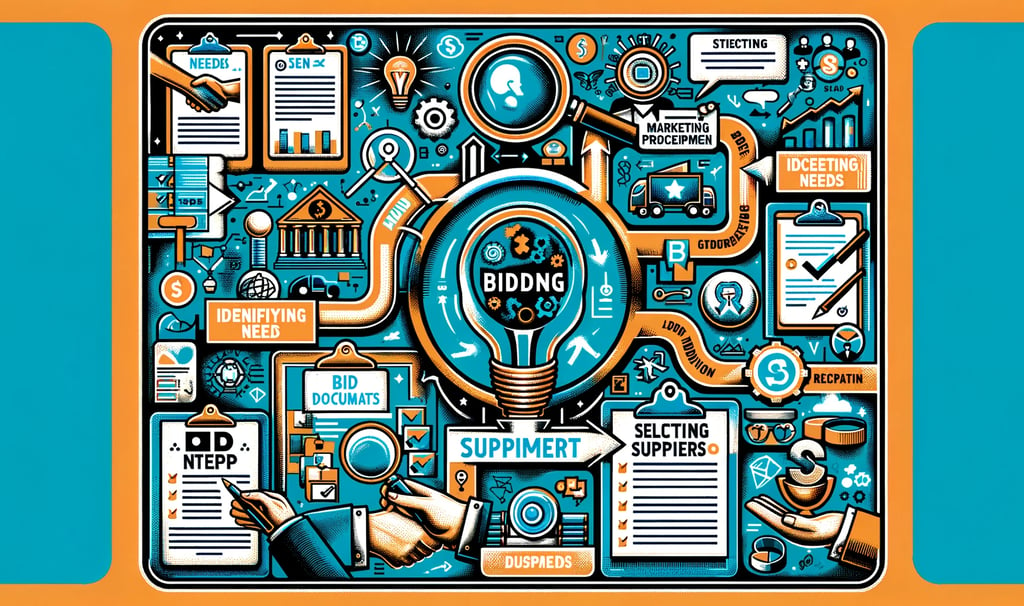The Bidding Process: A Step-by-Step Guide
What is the bidding process in procurement? This guide explains the 7 key steps, from identifying a need and issuing an RFP to evaluating bids and awarding a contract.
MARKETING PROCUREMENT
The Procure 4 Marketing Team
9/11/20233 min read


Quick Answer: What is the bidding process?
The bidding process is the formal, structured method a company uses to solicit competitive offers from multiple suppliers for a specific product or service. The process ensures fairness, transparency, and value. It involves 7 key steps: 1) Identifying the Need, 2) Developing the Bid Document (RFP), 3) Announcing the Bid, 4) Receiving Supplier Proposals, 5) Evaluating the Bids, 6) Selecting the Winner and Negotiating, and 7) Awarding the Contract.
What is the Bidding Process in Procurement?
The bidding process is a core procurement function designed to create a competitive and fair environment for selecting a supplier. Instead of just picking one company, a buyer invites several potential suppliers to submit a proposal, or "bid." These bids are then evaluated against a set of predetermined criteria to find the partner that offers the best overall value. This structured approach is essential for managing costs, ensuring quality, and maintaining transparency.
Let's walk through the 7 key steps using a simple, consistent example: a company needing to hire a new digital marketing agency for an SEO project.
The 7 Steps of the Bidding Process
Step 1: Identify the Need
The process begins when a clear business need is identified and documented.
Example: The marketing team's data shows that organic website traffic has been flat for six months. They identify a need for an expert SEO agency to improve their search engine rankings and drive growth.
Step 2: Develop the Bid Document (RFP)
A formal document, most commonly a Request for Proposal (RFP), is created. This document is critical as it outlines the project's scope, goals, deliverables, timeline, and budget.
Example: The procurement and marketing teams collaborate to create an RFP. It details the goal (e.g., "increase organic traffic by 30% in 12 months"), the budget, and the specific services required (e.g., technical audit, keyword research, content strategy, link building).
Step 3: Announce the Bid & Invite Suppliers
The RFP is then distributed to a curated list of potential suppliers. This can be done through procurement portals, industry networks, or direct outreach.
Example: The RFP is sent to a longlist of 8-10 pre-vetted SEO agencies that were identified through market research and professional recommendations.
Step 4: Receive and Manage Supplier Proposals
Interested suppliers will prepare and submit their proposals according to the guidelines and deadline specified in the RFP.
Example: By the deadline, the company receives 6 proposals from different SEO agencies. Each proposal outlines the agency's unique strategy, team, case studies, and detailed pricing.
Step 5: Evaluate the Bids
An evaluation committee reviews and scores each proposal against the predetermined criteria outlined in the RFP.
Example: The committee (including members from marketing and procurement) uses a supplier scorecard to rate each of the 6 proposals on criteria like:
Technical Expertise (25%)
Proposed Strategy (30%)
Relevant Case Studies (20%)
Cost (25%)
Based on the scores, the list is narrowed down to a shortlist of 2-3 finalists.
Step 6: Select the Winner & Negotiate the Contract
The shortlisted suppliers may be invited for a final presentation or pitch. After the final evaluation, a winner is selected, and contract negotiations begin.
Example: After the final pitch meetings, Agency B is selected as the winner. The procurement team then negotiates a final contract, ensuring the pricing, deliverables, and performance KPIs are clearly defined and agreed upon.
Step 7: Award the Contract & Provide Feedback
The final step is to formally award the contract to the winning supplier. It is also a best practice to professionally notify the unsuccessful bidders of the decision.
Example: The contract is formally awarded and signed with Agency B. The procurement team then sends a professional and courteous email to the other 5 bidders, thanking them for their time and informing them that another partner has been selected.
Frequently Asked Questions (FAQ)
Q1: What's the difference between an RFP, RFQ, and RFI? A: These are three different documents used in procurement:
RFI (Request for Information): Used early in the process to gather general information and create a list of potential suppliers.
RFP (Request for Proposal): Used for complex projects where the solution is not clearly defined. It asks suppliers to propose their unique solution and approach.
RFQ (Request for Quotation): Used for straightforward purchases where the requirements are very specific. It primarily asks suppliers to provide a price quote.
Q2: Should the lowest bid always win?
No. The goal of a strategic bidding process is to select the supplier that offers the best overall value, not just the lowest price. Factors like quality, experience, innovation, and reliability are often more important than a small difference in cost.
Q3: Is a formal bidding process necessary for all purchases?
No. A full, formal 7-step bidding process is typically reserved for strategic, high-value, or high-risk purchases. For smaller, routine, or low-risk purchases, a simpler process (like getting three informal quotes) is usually more efficient.

